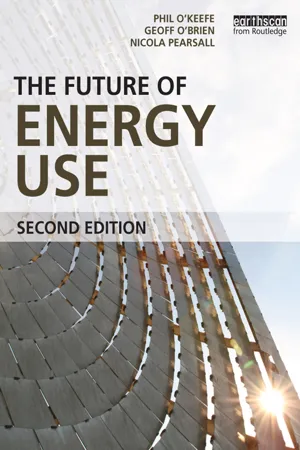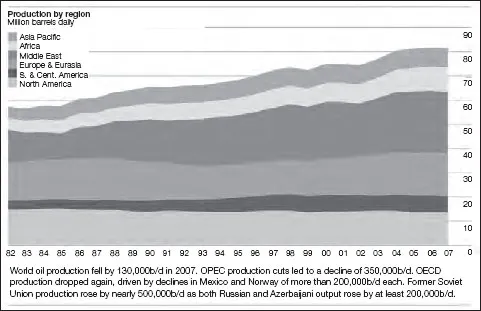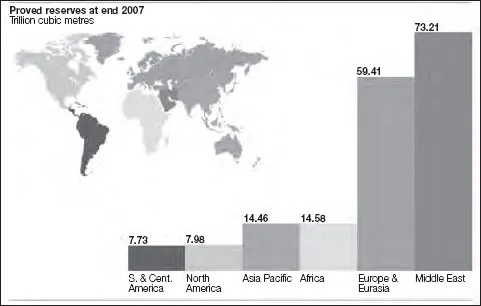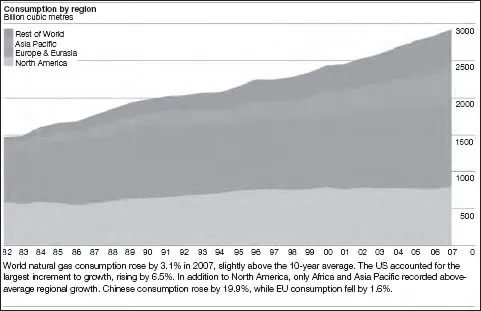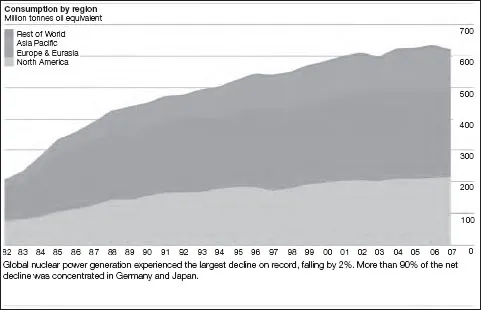![]()
1
The Changing Energy Landscape
Introduction
Why another book on energy, particularly from academics at Northumbria University, when past outputs have been, generally, very favourably received? The short answer is that the energy future for which we need to plan will have to be undertaken in an exceptionally different political economy of the 21st century. It may seem a contradictory starting point but, in general, the developed world and, as a consequence, the developing world, does not have a robust energy policy framework. Typically energy policy conclusions are drawn from environmental policy, such as the focus on renewables, yet environmental policy itself is not largely drawn from environmental considerations but from the requirements of market competition policy. In short, environmental policies, and the regulations and standards that follow from them are commonly drawn up to minimize unfair competition rather than address environmental concerns. Quite simply the market, however imperfect or distorted, rules.
Energy itself is fundamental to social development. Simultaneously, energy is central to one of the greatest environmental challenges humanity faces: climate change. Solutions to climate change will have a significant and lasting impact on the future of energy use. But climate change is not the only problem that the energy system faces. There are growing concerns about energy security, with real fears that geopolitical disruption could place many of the world’s economies in jeopardy. On top of this is the problem of the longevity of existing fossil fuel supplies. While coal appears to be plentiful, oil and gas have increasingly limited lifetimes. In 2008, there were rapid fluctuations in the price of energy supplies, with oil peaking near to US$150 a barrel at one point and falling to less than US$50 towards the end of 2008. The knock-on effects of this were increases in the cost of basic food stuffs as well as manufactured products, showing that energy is a fundamental component of our lifestyles. Some believe these price fluctuations signal that we have reached what is termed ‘peak oil’; where more energy oil reserves are used than are produced. Trying to think through energy futures with the pressing problems of climate change and issues of energy resource and energy price security is particularly difficult without an energy policy framework, since the market itself gives very mixed messages.
There are lessons to be learned from the recent oil price instabilities: the International Energy Agency (IEA) in its World Energy Outlook for 2008 says prices could rise to as high as US$200 a barrel by 2030. The era of cheap oil is over. However, as the IEA points out, the reasons for rising prices lie not in the shortage of energy resources but a lack of investment in energy infrastructure. The IEA argues that such investment in infrastructure (for example, exploration and refinery capacity) will amount to approximately US$26 trillion by 2030. The paradox is that if we continue to rely upon and invest in fossil fuels without investing in measures to address the carbon problem then the climate consequences could be severe (IEA, 2008).
Note: Area between dashed line and data points is 500EJ/year and represents everyone below Poland today achieving this same energy usage of 100EJ per capita
Source: World Energy Council (WEC), 2007
Figure 1.1 Energy per capita as a function of cumulative population
Renewable technologies are the obvious answer to the carbon problem but they only provide a fraction of the world’s energy capacity. Some 80 per cent of global energy is produced from fossil fuels, while some 13 per cent is produced by traditional biomass, with the rest being produced by a mixture of nuclear, hydropower and other renewable technologies.
In summary, the major influences on the future of energy use will be mitigating climate change using low-carbon and renewable energy sources, improving energy security and ensuring a smooth transition into new forms of energy technology use. Each on its own will be difficult and, collectively, represent a major challenge to the global community. In this book we explore the issues around these topics as well as look at the current trends in the energy system and some of the proposals that have been made to deal with the carbon problem. We also touch briefly on global climate agreements as these will have a profound effect on the future of energy use.
Energy and gross domestic product
There has always been a close link between social development and energy use. In brief, this has meant that as economies have grown there has been a corresponding growth in energy demand. This close coupling between economic growth and energy demand has been a feature of societies up until recently, where, for instance, focused efforts in Japan to decouple energy use and economic growth have become increasingly prominent. Energy intensity is something which governments are looking at quite seriously as one of the tools to be used in reducing greenhouse gas emissions. However, the picture is not quite as simple as that. Energy demand is heavily influenced by prevailing climate conditions, lifestyles and income, as can be seen in Figure 1.1. Two striking observations about the graph are the high consumption in oil-rich countries and the relatively low consumption in India and China, the most rapidly industrializing countries.
Many of those countries above 100EJ per capita are what are commonly termed as developed world countries. Typically it is this collective of countries that are members of the Organisation for Economic Co-operation and Development (OECD); 30 in total, which make up the developed world. It is important to note, however, that other countries, such as Russia and Kuwait, for example, though not members of the OECD, still have high energy use per capita, mainly due to prevailing climatic conditions. Kuwait, for instance, has a typically constant hot, dry climate, whilst Russia on average has a particularly cold climate.
In the near future other factors will significantly shape the demand for energy. These include a growing world population (estimated to rise by at least another one billion by 2025 and perhaps, eventually stabilizing at 9 billion people), and the rapidly rising percentage of the world’s population moving from rural to urban areas. Many rural to urban migrants, particularly in Asia, quickly emulate Western lifestyles as incomes increase (greater per capita income), in turn, expanding the number of those joining the middle classes. This scenario is almost certainly true when considering the future despite recent global economic decline. Together, these demographic changes are likely to increase demand for scarce energy resources. This will run parallel to emerging constraints on new production partially through the control exercised by state-run companies and partially by climate concerns. This implies that the future of energy is unlikely to be determined by market forces. Climate concerns, energy security and technological developments are the most likely determinants of the future of energy.
Studies focusing on the likely mix of energy resources suggest that for some years to come the supply side will be dominated by fossil fuels. The IEA (2008) predict that there are sufficient oil and gas reserves to meet current and projected demand for the next 40 years. Coal reserves are sufficient for the next few hundred years. The issue is not lack of reserves but whether or not ways can be found to use these supplies in ways that do not jeopardize future generations.
Global energy resources
There is considerable debate about global energy resources and their longevity. Coupled with this debate is the ongoing and increasing apprehension that if we do not find clean ways of using fossil fuels or renewable technologies, severe impacts upon the climate system will become more frequent and increasingly difficult to overcome. For many OECD nations, the paramount concern lies with security of supply as many of the existing or proven reserves are in areas regarded as geopolitically unstable, which could in turn jeopardize supplies. Figures 1.2, 1.3 and 1.4 show proven oil reserves, consumption and production for 2007 (BP, 2008). The Middle East is currently the most geopolitically unstable region of the world, in part because of wars generated by developed countries.
From these figures it is relatively straightforward to calculate the expected longevity of current reserves at the daily consumption rate for 2007. This gives a value of:
(1208.2 thousand million barrels/83,719 thousand barrels per day)/365 = 38 years.
This figure will change if, as expected, demand for oil increases, particularly in the industrializing countries of India and China. However, there are still considerable reserves of non-conventional oil such as tar-sand, shale and heavy oils that could be exploited to meet demand. These are discussed in more detail in Chapter 5.
The case for natural gas is even more promising in terms of resource longevity. Figures 1.5, 1.6 and 1.7 show proven gas reserves, consumption and production for 2007 (BP, 2008).
The longevity of proven natural gas supplies can be calculated from the reserves and consumption figures (expressed in cubic metres) as:
Source: BP, 2008
Figure 1.2 Proven oil reserves by area
Source: BP, 2008
Figure 1.3 Oil production by region
(181.6 trillion/2.8 billion per day)/365 = 175 years.
Again, this value will change as consumption rates as expected, increase. In contrast to oil there are no other types of gas resource that can be exploited through conventional exploration techniques. Although other methods of producing gas are available, such as the gasification of coal seams. This is discussed in more detail in Chapter 5.
Resources such as coal, (see Figure 1.8) are relatively plentiful, for which the lifetime of current reserves is thought to be in excess of 150 years (BP, 2008).
Source: BP, 2008
Figure 1.4 Oil consumption by region
Source: BP, 2008
Figure 1.5 Natural gas reserves by area
In terms of fossil fuels it can be argued that sufficient resources are available to meet current demand. If demand continues to accelerate at the current rate, then it is likely that a resource constraint in terms of availability may become a contentious issue. This is illustrated best by inspecting resource and consumption maps, which clearly show that the distribution of resources does not match consumption locations. This is likely to be increasingly problematic in terms of energy security.
Other forms of energy supply that produce a significant amount of power are nuclear and hydroelectric power, as shown in Figures 1.9 and 1.10 (BP, 2008). Figure 1.11 (again from BP (2008)) shows world energy consumption by fuel type. What is clear from all the figures shown is that demand for energy has increased over given reporting periods. It is apparent that demand for energy is predicted to increase. The speed at which demand will grow is uncertain and will depend upon a range of factors. Determining future energy demand is difficult and in many ways is more of an art than a science. Ways in which energy futures, using examples from developing countries, are predicted are discussed in more detail in Chapter 3.
Source: BP, 2008
Figure 1.6 Natural gas production by region
Source: BP, 2008
Figure 1.7 Natural gas consumption by region
Source: BP, 2008
Figure 1.8 Proven coal reserves by area
Source: BNP, 2008
Figure 1.9 Nuclear power by area
Energy futures
Although there are a number of different energy predictions as discussed in Chapter 2, Figures 1.12 to 1.16 give a sense of what many believe is likely to happen in the future. In general, pre...
